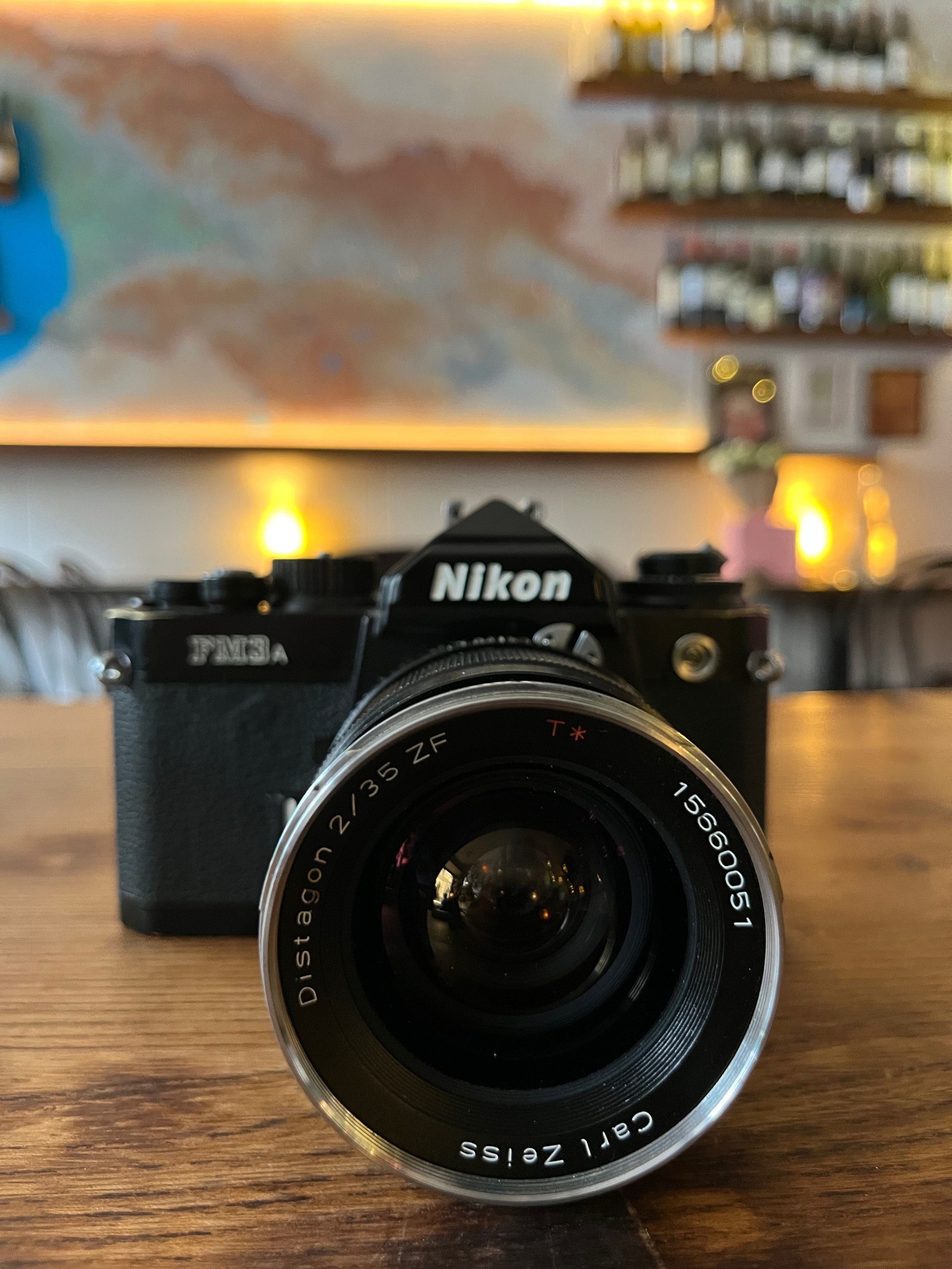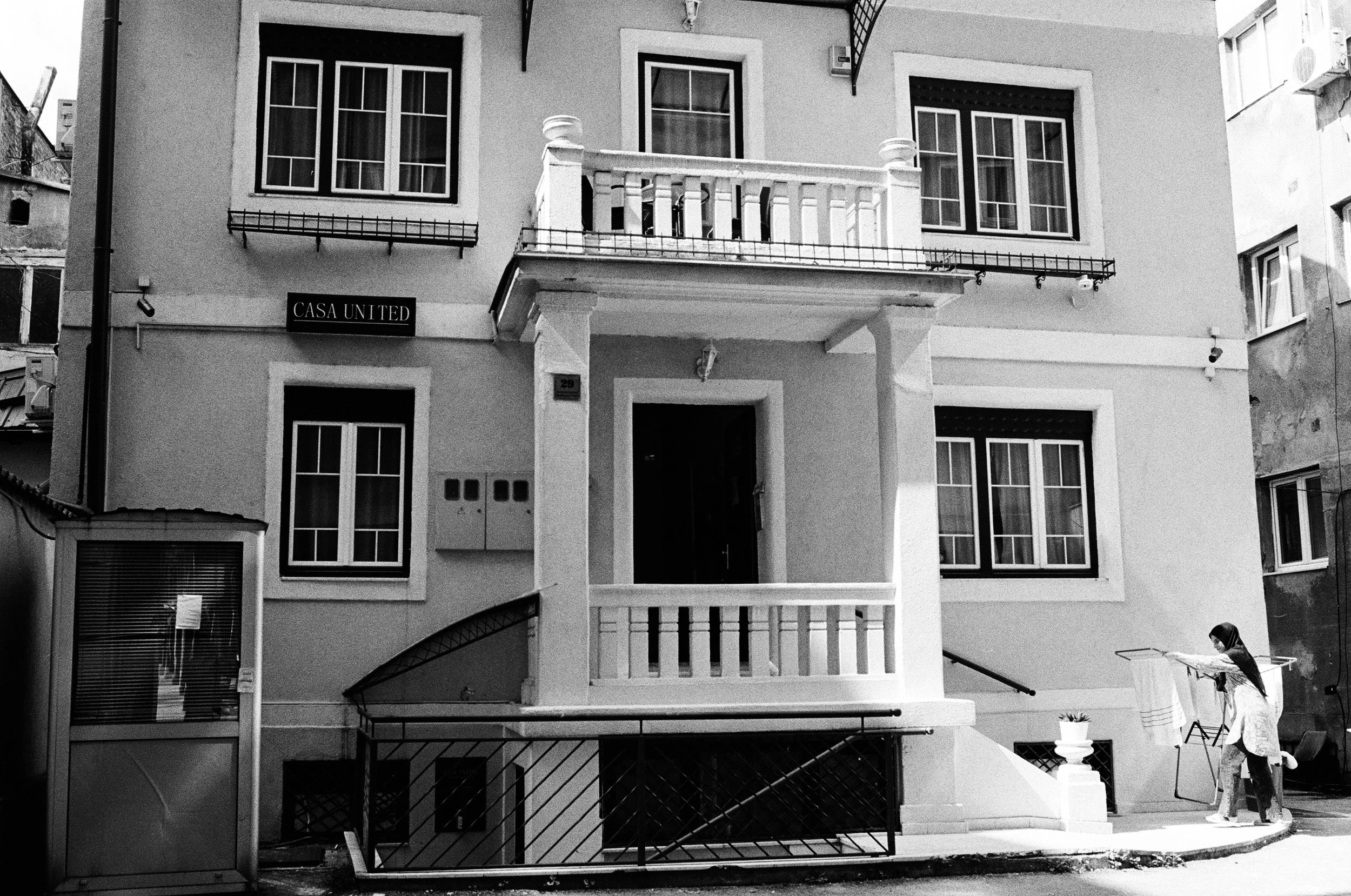Is this the best Film Camera, Lens & Film combination for a classic look? Captures with a Nikon FM3A, Zeiss Distagon 2/35 ZF and Kodak Tri-X in Sarajevo, Bosnia & Herzegovina | Summer 2024
I was itching to hit the streets of a City with a combination I’ve long been wanting to try out. I recently acquired a copy of the beautiful Carl Zeiss Distagon 35mm F2 which I’d previously borrowed from a friend and loved when shooting colour emulsion - I knew this lens packed a 3D pop but I hadn’t yet had the chance to use her with a nice contrasty grainy film like the classic Kodak Tri-X and to crank things up a notch I used a medium yellow filter on the front of the lens, which whilst taking almost a stop of light transmission made the blacks that bit more inky and the contrast and grain a little more accentuated.
We’d already crossed Georgia, Turkey and Europe from Tbilisi to London and then headed down to the Alps and Slovenia when we made a new friendship one evening that piqued our interest to visit Bosnia & Herzegovina on our way towards our intermediate destination of Athens, Greece. After a little colour 120 film photography in London and Tyrol I was itching to hit the streets of a City with a combination I’ve long been wanting to try out. I recently acquired a copy of the beautiful Carl Zeiss Distagon 35mm F2 which I’d previously borrowed from a friend and loved when shooting colour emulsion - I knew this lens packed a 3D pop but I hadn’t yet had the chance to use her with a nice contrasty grainy film like the classic Kodak Tri-X and to crank things up a notch I used a medium yellow filter on the front of the lens, which whilst taking almost a stop of light transmission made the blacks that bit more inky and the contrast and grain a little more accentuated.
Habsburg Empire Grandeur
Art Deco detailing
Bauhaus Modernism
I already knew that the Nikon FM3A would perform admirably, whilst lacking the 100% viewfinder coverage of the F3 she replaced I know I can always be confident that I’ll get the shot thanks to the ingenious hybrid shutter that works electronically in Aperture Priority mode (often my preferred method because I want to concentrate on composition and I trust the light meter) or if necessary manually at all speeds when shooting full manual - something that gives confidence if you should happen to run out of LR44 batteries or be in a freezing cold environment - I think the FM3A is one of those bodies you could happily take to Siberia in Winter and be sure you’ll make the photos you want without any worries.
I adore the shadow graduations in this image
Whenever I’m working with negative process film I set the camera to EV +1 - the reason I do this is that negative vilm has a habit of losing detail in the shadows - something you can easily recover on digital, not so on film… so where I shoot my Pentax K1 habitually at EV -1 because she has the habit of blowing highlights the converse is true when shooting an old-school SLR like the Nikon, of course because I’m using the in camera meter compensation is made by the meter as I’m taking the shot
Strong Brutalism
Muslim Tourists file past one of the famous Bars of Sarajevo
The majority of images on this roll were shot at apertures around F5.6, some were F8 or F4 but my aim was to stick around the sweet-spot of sharpness to make the most of the famous 3D Pop this Zeiss lens produces - I’d argue that the look created is very close in terms of quality and character to Leica lenses.
Buildings still pock-marked with bullet holes, yet peace is the main thing in Sarajevo these days
Carl Zeiss Distagon 2/35 mounted on my nicely worn-in Nikon FM3A (yes I use a lens-hood and the yellow filter is missing here)
The later models of FM3A - Serial Number 300xxxx+ produced in 2005/6 don’t have leatherette, instead Nikon used a grippy rubberised finish, whilst this doesn’t wear so well it does make the camera easier to handle; with a front-heavy lens like this I could really do with a nice wooden handgrip like I’ve seen on eBay recently - whisper it, but I’ve noted that some Chinese manufacturers are producing what look to be really nice grips - I’ll have to buy one and let you know how it feels… I mean, I already have a fair idea how this will improve the handling because I shoot big-gripped cameras on digital with big heavy lenses and that extra purchase you get is essential - so yes, if you’re considering using the Distagon 2/35 on a classic style SLR from Nikon, Canon or Pentax (the main mounts these lenses are made with) then yes, you may well want to think about a handgrip of some description.
1970's functionalism
As always reviews like this are totally unscientific, my aim is to give you an impression of the sort of photos a combination produces so that you can develop a subjective impression as to whether you like this look or not, as part of my photographic practice I spend a lot of time developing my taste in equipment because at the end of the day once you’ve mastered technique - yes it really does matter what equipment you use, camera bodies matter less, but lenses, filters and film or sensors really do make a difference. So if you’re here because you’re curious - you’ve come to the right place. I also like to give props to my local Lab - Qwerty Film Lab in Tbilisi, Georgia who did the whole dev & scan - thanks guys.
Washing Day
Finally let’s talk about the film stock… Kodak do make a finer grained 400 ASA film stock, that is called TMax - if you want the smoothest possible look, go for that, I think that’s a really nice emulsion that delivers beautiful results, yet for me that classic slightly rougher and larger grain of Tri-X has a more “emotional feel” for me… pore over the images I’ve shared and I think you’ll see what I mean.
If you’d like to support what I do, why not get yourself a print? You can find what I believe to be the best capture from this roll right here, alternately you can find a wide range of film images I’ve shot here…
If you have any questions about what I’ve written here - hit me up in the comments! Ax























